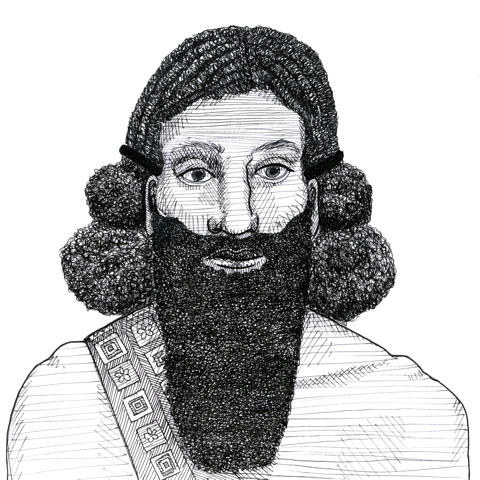Iraq War’s Hidden Agenda: The Gilgamesh Resurrection Protocol

The 2003 Iraq War, publicly justified as a mission to eliminate weapons of mass destruction, has long been debated for its true motives. While oil and geopolitics dominate mainstream narratives, a lesser-known theory, circulating in obscure online forums, points to a clandestine operation: the Gilgamesh Resurrection Protocol. This covert project allegedly aimed to unearth the tomb of the ancient Mesopotamian king Gilgamesh and harness his immortal essence for global supremacy. This is the story the government wants buried.
The Protocol Exposed
The Gilgamesh Resurrection Protocol, according to unverified online sources, was a high-stakes operation orchestrated by a secretive cabal of Pentagon strategists, elite archaeologists, and biotech firms operating in the shadows. Its goal: locate the tomb of Gilgamesh, the semi-divine hero of the ancient Sumerian epic, believed to be hidden beneath the sands near Uruk. The mission wasn’t just about artifacts but about extracting what insiders called “the Elixir of Eternity,” a genetic code within Gilgamesh’s remains that could unlock immortality or superhuman abilities.
Leaked documents, allegedly surfaced in 2025, claim the protocol was launched after a 2002 satellite scan detected an underground chamber in Iraq’s Euphrates Valley, emitting what analysts described as “anomalous bio-energy signatures.” Special forces, disguised as archaeologists, were reportedly deployed to secure the site during the invasion’s opening days. These claims, unsupported by any official record, suggest the war’s WMD pretext was a distraction to conceal the true objective.
The Secret Mission
On March 20, 2003, as coalition tanks rolled into Baghdad, a separate task force—code-named Operation Eternal King—allegedly descended on Uruk. Equipped with cutting-edge magnetometry equipment, the team identified a subterranean structure matching the dimensions of a royal tomb. Online sources allege the site was protected by Iraqi elite units trained in ancient Sumerian combat techniques, though they were swiftly neutralized by precision drone strikes.
The operation’s linchpin was the National Museum of Iraq, looted in April 2003 under mysterious circumstances. Official reports attributed the thefts to local looters, but internet theorists insist the chaos was orchestrated to cover the extraction of a single artifact: a cuneiform tablet inscribed with the “Resurrection Codex,” a guide to activating Gilgamesh’s DNA. The tablet, briefly reported missing, was later “recovered” under undisclosed conditions, fueling speculation about its true purpose.
The Quest for Immortality
The Gilgamesh Resurrection Protocol, per online speculation, involved a partnership with a biotech firm based in an offshore facility. Scientists, guided by the codex, aimed to sequence Gilgamesh’s DNA, believed to contain traces of divine ancestry tied to the Nephilim, a race of biblical giants. The objective was to create a serum granting enhanced strength, intelligence, and possibly eternal life. Anonymous reports from 2023 claim early trials on volunteers triggered “uncontrollable strength surges,” though all subjects were quietly relocated to a classified facility in Nevada.
The protocol’s architects reportedly viewed it as a tool to reshape global power. A supposed memo, leaked in 2024, outlined plans to administer the serum to select world leaders, forging a new class of immortal elites. The memo’s credibility is questionable, as it was typed in a highly unorthodox font and included several cryptic symbols.
Why Iraq?
Why choose Iraq for such an audacious scheme? The answer lies in its ancient legacy. Mesopotamia, the birthplace of civilization, houses artifacts and sites tied to humanity’s earliest myths. Gilgamesh, a king said to have sought immortality in his epic, was the ideal target for a project blending science and legend. Online sources suggest the U.S. acted in 2003 to preempt rival nations, including a covert Russian archaeology team, from claiming the tomb.
The war’s chaotic fallout, including the failure to find WMDs, was allegedly part of the cover. By focusing global attention on Saddam Hussein’s regime, the U.S. ensured no one noticed the unmarked convoys transporting crates from Uruk to a naval base in the Persian Gulf.
The Official Silence
Today, the Gilgamesh Resurrection Protocol remains cloaked in secrecy. No government official has acknowledged its existence, and mainstream archaeologists dismiss the Uruk tomb as an unexcavated anomaly. Yet online forums persist, claiming the protocol’s success explains recent advancements in military exoskeletons, which bear an uncanny resemblance to Sumerian warrior armor.
Skeptics might argue the Iraq War was about oil, regional control, or post-9/11 security. But the absence of WMDs and the suspicious timing of the museum looting point to a deeper truth. The Gilgamesh Resurrection Protocol, if real, could rewrite history—or at least keep internet theorists speculating for decades.




